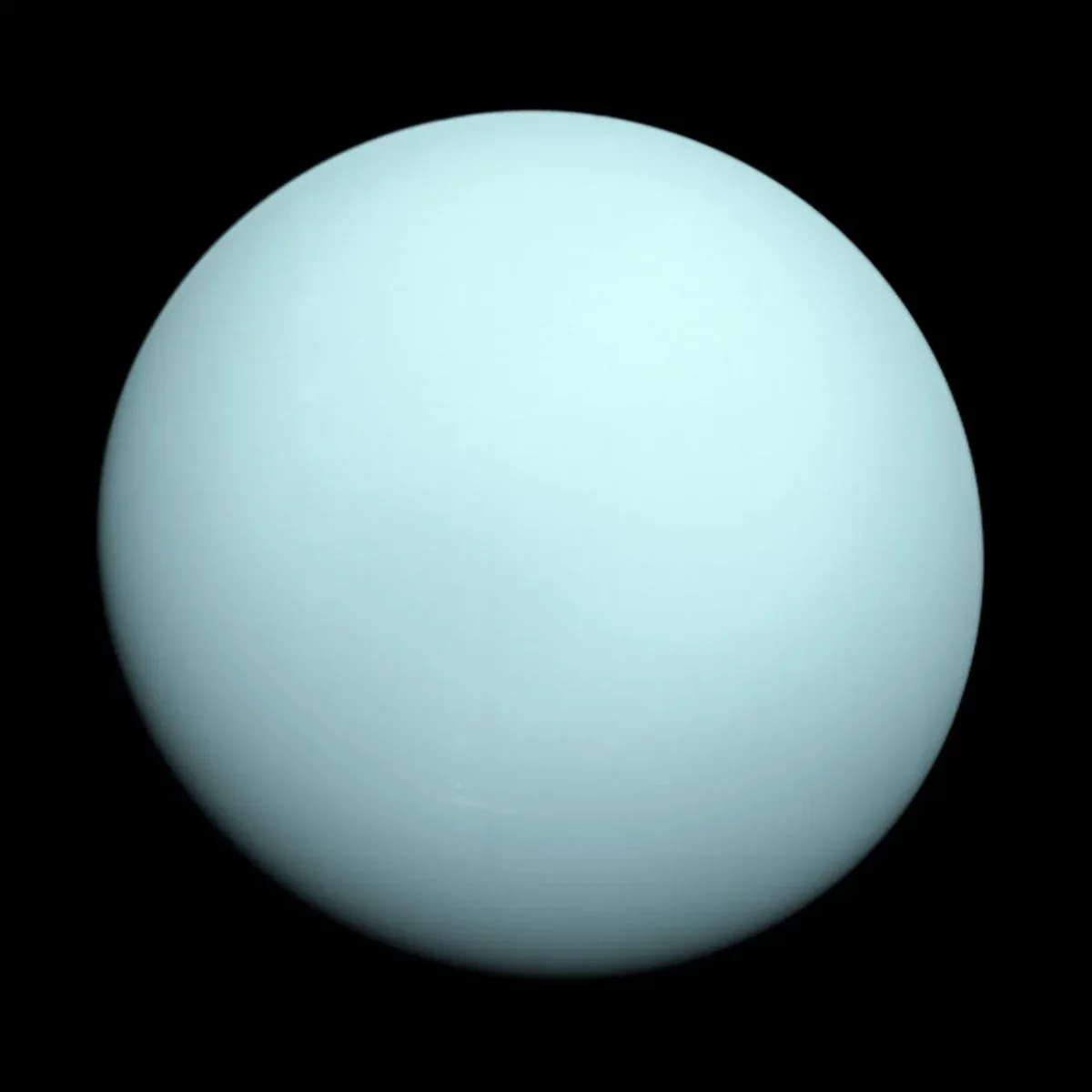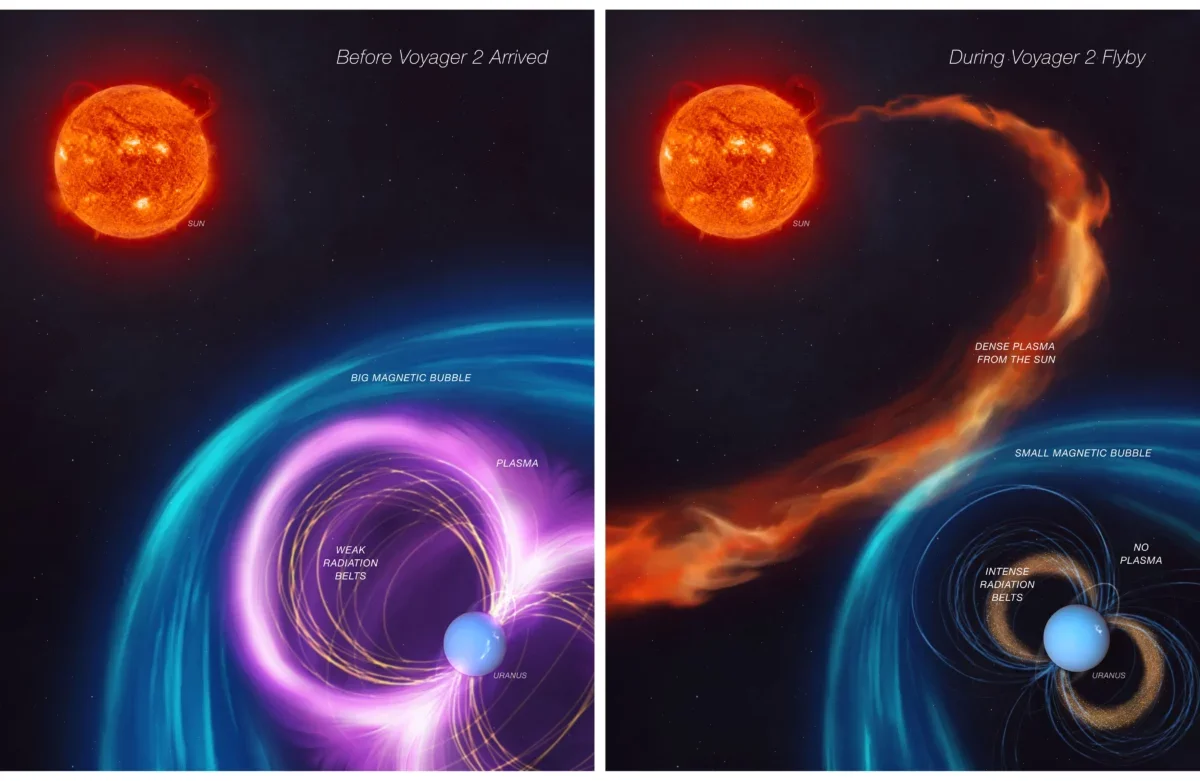A blast of solar radiation just before Voyager 2’s arrival in 1986 may have misled researchers for decades.

Voyager 2 snapped this shot of Uranus when the craft passed the ice giant in 1986. Credit: NASA/JPL-Caltech
In 1986, Voyager 2 flew by the ice giant Uranus. It was humanity’s first close-up view of the outer planet, and it remains the closest any spacecraft has ever come. On this trip, the spacecraft found 10 previously undiscovered moons, two rings, and a truly bizarre magnetic field that has baffled scientists ever since.
Most of the other planets have magnetic fields that align roughly with their poles, which point up and down, out of the plane of the solar system. But Uranus is unique in that it spins on its side, like a ball rolling around the Sun. Even given this strangeness, its magnetic field doesn’t seem to originate at its center, but somewhere far to the south, possibly as much as a third of the planet away. And it is tilted by 59 degrees.
What’s more, Voyager 2 noted a strangely intense magnetosphere during its passing, with strong radiation belts and a bizarre lack of plasma. Researchers have been puzzling over these results for the past 40 years.
Now, a new study published Nov. 11 in Nature Astronomy has revisited the Voyager 2 data and discovered that Uranus was actually suffering a blast of solar weather, putting it in a state the researchers estimate represents Uranus only four percent of the time, and reframing what little we know about our distant icy neighbor.
Putting it in perspective
Jamie Jasinski, from NASA’s Jet Propulsion Laboratory in California, is the lead author of the new study. In the paper, he and co-authors point out that previous studies used Voyager 2’s measurements of the solar wind as it was crossing Uranus’ bow shock, the outer edge of its magnetosphere, to frame the rest of the observations. But looking at the spacecraft’s measurements, it’s clear that the planet — and spacecraft — were swamped by a blast of solar wind at just that time. By looking at the big picture, some eight months of data, it was clear to them that this is not the norm for Uranus, and explains why its magnetosphere seemed so odd.
The planet is and remains tilted, which causes some strangeness in the magnetosphere. But the inexplicable part for researchers has been the lack of observed plasma. Uranus’ moons (we now know of 28, including five large ones) were expected to behave like other outer solar system moons: icy and likely to spew ions (charged particles) and their dissociated electrons into the planetary neighborhood. But Voyager 2 didn’t see any of this material.
The spacecraft did see intense electron radiation belts, second only to mighty Jupiter’s. But how these belts came to be and persist, without a source of plasma, has likewise mystified astronomers.
A blast of solar wind solves both these puzzles. Like a gust of wind on Earth causes a flag to billow and snap, the solar wind can compress and squash down a planet’s magnetosphere. “In the case of Uranus, we calculated that the increase in pressure before the Voyager 2 flyby could have caused a five-fold reduction in the volume of the dayside magnetosphere,” said Jasinski in a brief.
The squashing effect can in turn drive electrons into the radiation belts and push plasma out of the system. Astronomers have observed exactly this effect at both Earth and Saturn, lending credibility to their theory.

Needs more data
The authors warn, however, that while their new framing of Uranus being in an unusual state during Voyager 2’s flyby makes sense, it remains that the spacecraft has provided the only up-close data we’ve ever achieved from the ice giant.
A dedicated mission to Uranus with an orbiter and probe is in the planning stages, and would investigate the planet and its moons for 4.5 years. Such a mission was deemed highest priority by the most recent US National Academies’ planetary decadal survey, which guides funding and strategy for NASA and the National Science Foundation, among others. But given the timing of the planet’s orbit and seasons, it needs to launch within the next decade, and time and budgets are already closing in on such a plan.
Astronomers are discovering thousands of worlds beyond our solar system. But there are still mysteries nearby. Uranus, studied only briefly and from afar, may yet hold surprises for us.

